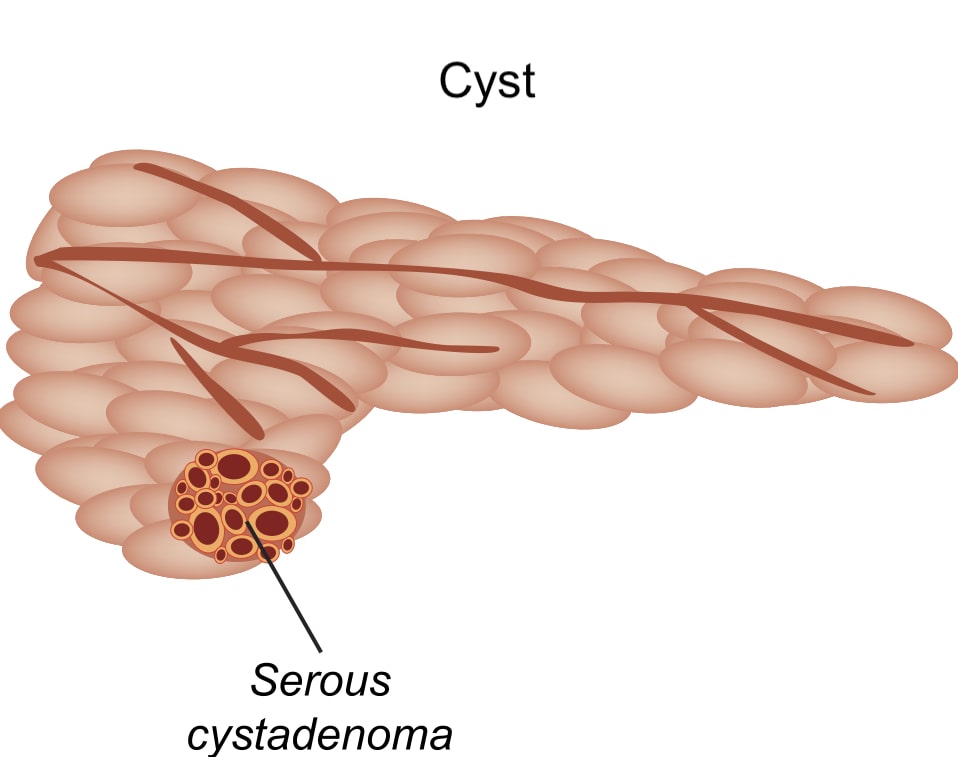Pancreatic Cyst
What are Pancreatic Cysts?
Pancreatic cysts are pockets of fluid in or around your pancreas. The pancreas is an organ located behind the stomach. It is responsible for producing hormones such as insulin and digestive enzymes. Pancreatic cysts are commonly found incidentally during health screening or during radiologic imaging for complaints such as abdominal pain which may be unrelated.
Pancreatic cysts can be categorised into two groups, benign or neoplastic cysts. There are many different types of cysts, such as pseudocysts, serous cystadenomas and mucinous cystic neoplasms. Most small cysts are usually benign and do not cause any symptoms. However, when these cysts start to grow, the risk of turning into a cancerous form increases.

- Abdominal pain and bloating or fullness
- Back pain
- Shoulder pain
- Nausea and vomiting
- Jaundice and dark urine
- Fever
- loss of weight and loss of appetite
- Blood Tests
- Ultrasound
- Computerised Tomography (CT) Scan
- Magnetic Resonance Imaging (MRI)
- Endoscopic Ultrasound
In most cases, your doctor will recommend monitoring a cyst over time for changes such as an increase in size that suggest a risk of cancer. Your doctor may advise obtaining a sample of the pancreatic cystic fluid to check for cancer cells if the cysts are large.
The characteristics of the pancreatic cyst on radiologic imaging, along with risk factors such as your age and sex, can help with diagnosis:
- Pseudocysts are benign and are usually a delayed complication after an episode of pancreatitis. They can also be caused by trauma to the pancreas.
- Serous cystadenomas occur most frequently in women older than 60 and only rarely transform into cancer.
- Mucinous cystic neoplasms occur predominantly in women and are usually situated in the body or tail of the pancreas. Mucinous cystadenomas do have a higher risk of cancer, and usually need to be treated. Larger cysts may already contain cancer cells when found.
- An intraductal papillary mucinous neoplasm (IPMN) arises in the main pancreatic duct or from one of its branches. IPMN may be precancerous or cancerous. It can occur in both men and women older than 50. Depending on its location and size, IPMN may require surgical removal.
- Solid pseudopapillary neoplasms are usually situated in the body or tail of the pancreas and occur most commonly in younger women. They are rare but have the potential to turn into cancer.
A cystic neuroendocrine tumour is mostly solid but with some cystic parts. They may be benign or cancerous at the time of diagnosis.
Regular Surveillance of The Cyst
- Your doctor will discuss regular surveillance imaging with you depending on the characteristics of the cyst including its size and whether you have symptoms.
Drainage
- Aspiration of cyst is needed, especially when an existing cyst causes symptoms or further investigation of cyst content is required. Your doctor may advise aspiration of the cyst either radiologically or endoscopically.
Surgery
- In some cases where there is a risk of cancer, pancreatic cysts will need to be surgically removed. Furthermore, surgery can be used to remove a large pseudocyst or a serous cystadenoma that is causing symptoms.




